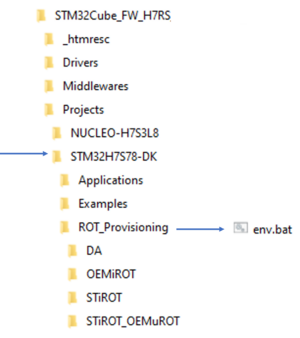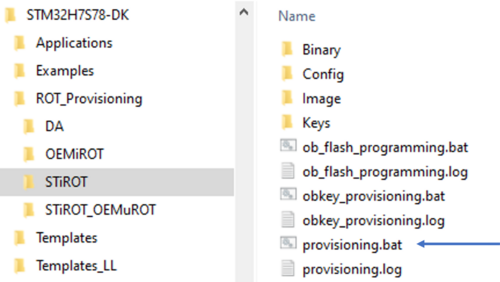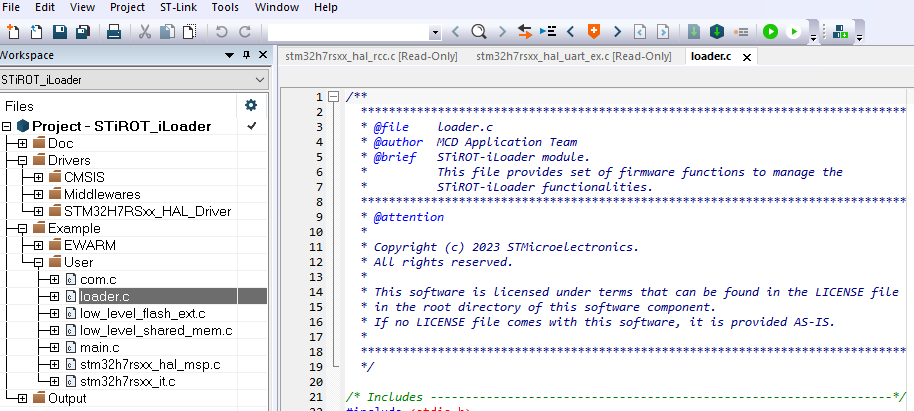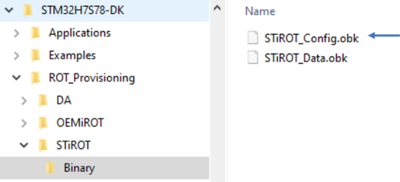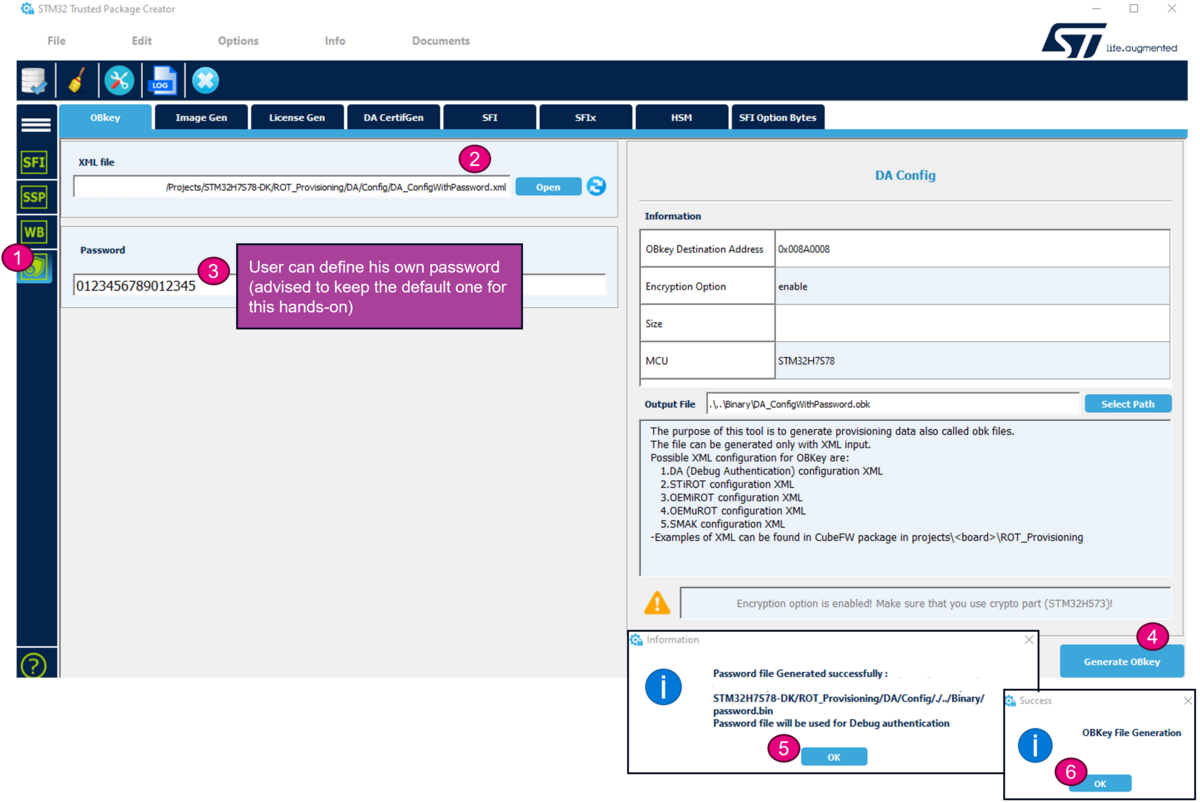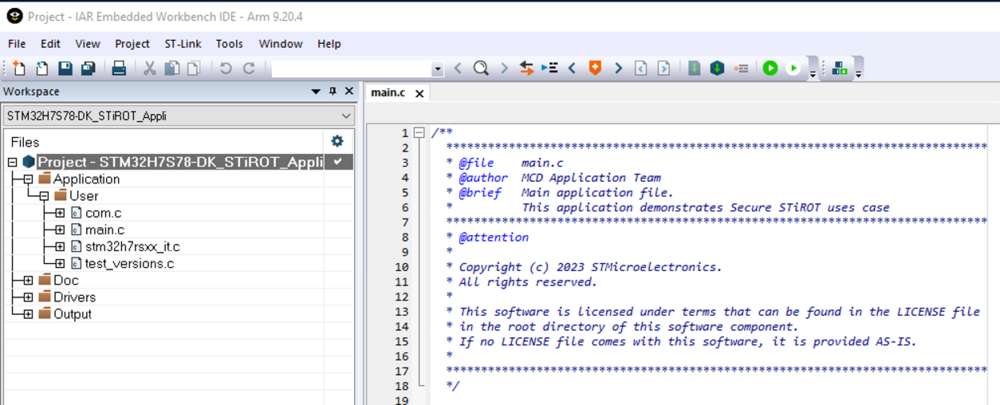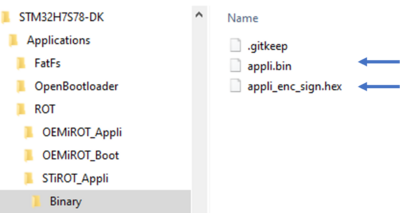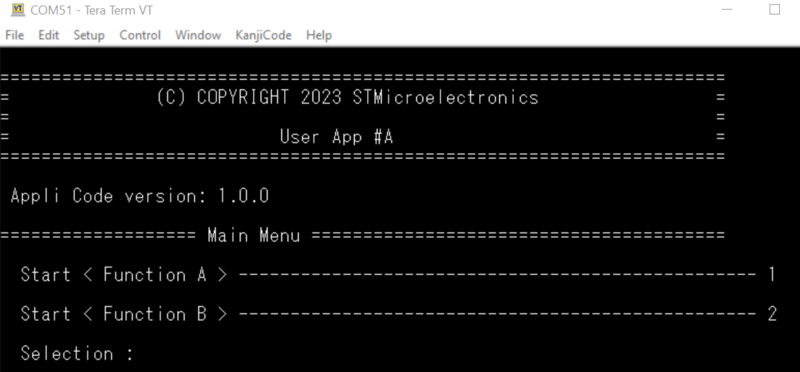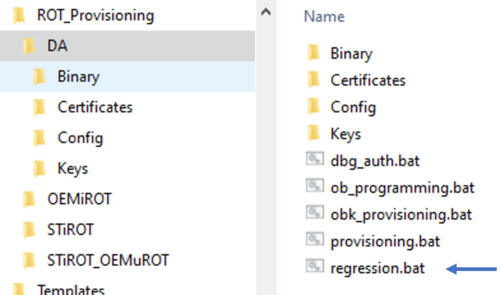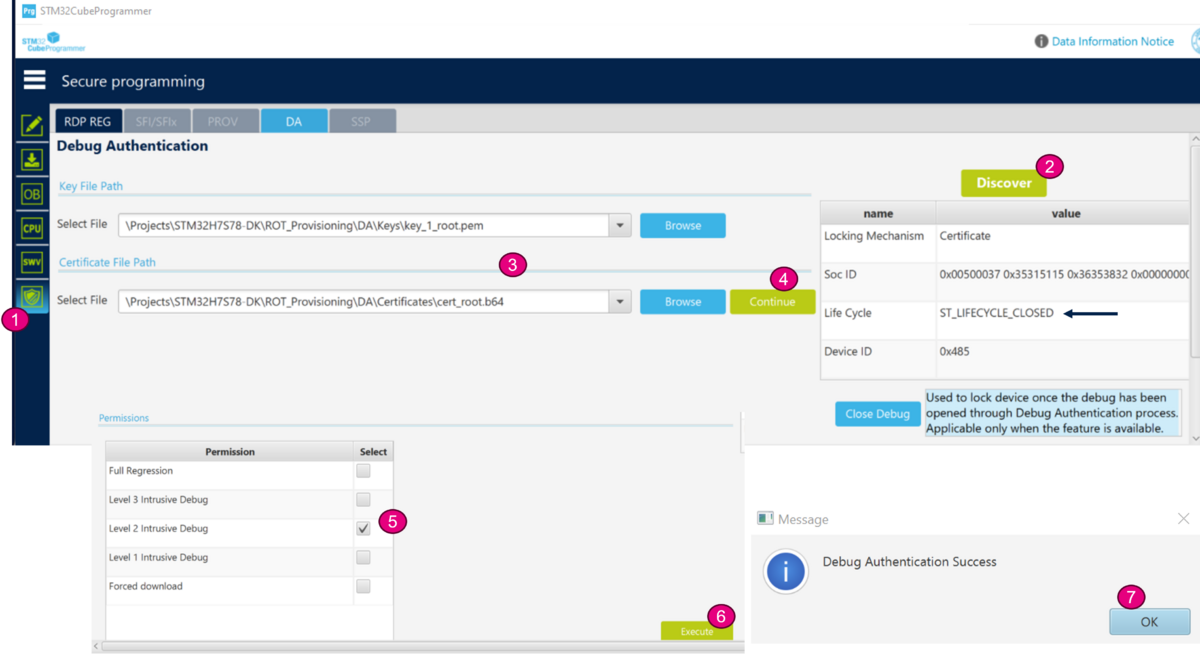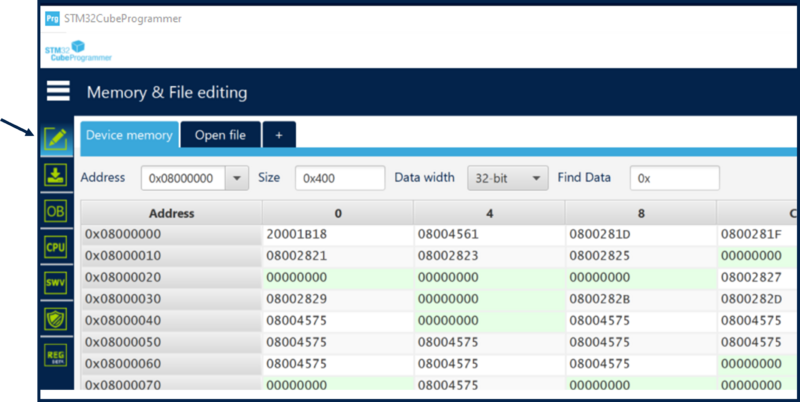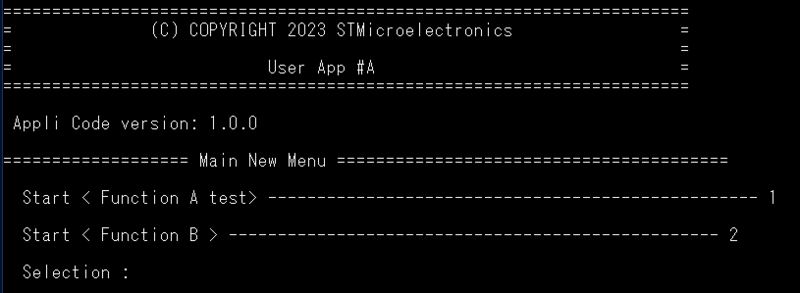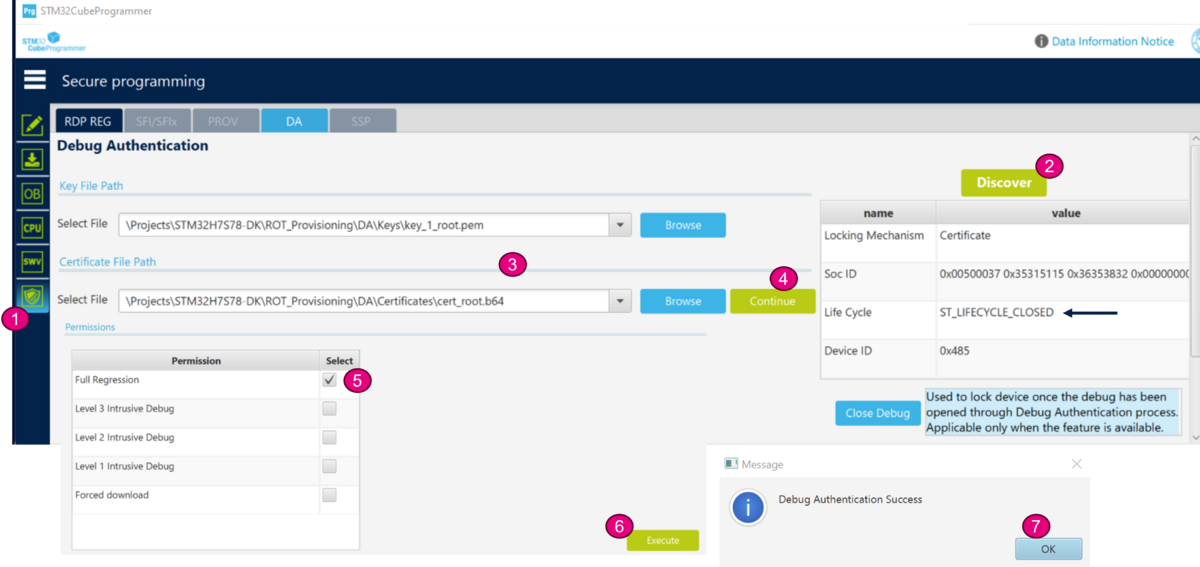How to start with STiRoT on STM32H7S
Literature
- Wiki pages:
- STiRoT STM32H7S How to Intro article
- STiRoT for STM32H7S article
- STiRoT article.
- Debug Authentication for STM32H7RS article
- Debug Authentication STM32H7RS How to Introduction article
- UM2237 STM32CubeProgrammer software description
- UM2238 STM32 trusted package creator (TPC) tool software description
- AN5054 Secure programming using STM32CubeProgrammer
Target description
The purpose of this article is to explain step by step how to use the STM32CubeFW example provided by ST, for STiRoT, using the STM32H7S discovery board.
- Chapter1: describes an example of provisioning using password and a full regression using the STM32CubeFW script.
- Chapter2: describes an example of provisioning using the root key and a certificate.
Based on this STM32CubeFW example, additional exercises are proposed (debugger opening, attach an IDE to make a step-by-step user application execution, modification of the user application and upload of the modified firmware) in the How to start with DA access on STM32H7RS, Debug Opening section article.
Introduction
Two examples are provided in the STM32Cube_FW:
- An example with a single boot stage: STiRoT
- An example with two boot stages: STiRoT - OEMuRoT
The single boot stage example is used in this "getting started".
Through this practical example you will learn:
- What is STiRoT for STM32H7S and how to use the STM32CubeFW example which is provided.
- How to configure the STiRoT and the debug authentication for this example.
- What is the iLoader and its role.
- How to generate an encrypted and signed image for the user application firmware.
- What the device provisioning is and how to perform the setup of the device.
- How the user application is installed.
- How to perform a regression to retrieve an empty board.
Prerequisites
- Hardware
- STM32H7S discovery board: the STM32H7S devices have all the available security features, including the HW crypto accelerator (the HW cryptographic acceleration is not support for STM327R devices).
- Discovery MB1736- STM32H7S (need USBC cable)
- STM32H7S discovery board: the STM32H7S devices have all the available security features, including the HW crypto accelerator (the HW cryptographic acceleration is not support for STM327R devices).
- Required tools
- STM32Cube_FW_H7RS_V1.0.0RC3 or later
- STM32CubeProgrammer_rev0.0.7-H7RS-B01 or more recent (with trusted package creator (TPC) selected at installation).
- IAR Embedded Workbench® rev 9.20.1 or later.
- IAR Patch EWARMv9_STM32H7R-Sxx_V0.10.0 or later
- Tera Term / Putty or equivalent terminal emulator.
- STM32Cube Firmware
- Download the STM32Cube_FW_H7RS Cube firmware (advise is to place it close from the C: in order to avoid long windows paths)
- A directory STM32H7S78-DK is included in "STM32Cube_FW_H7RS\Projects"
- Open the env.bat file
- If the STM32CubeProgrammer has not been installed in the default folder:C:\Program Files\STMicroelectronics\STM32Cube\STM32CubeProgrammer, the customized installation path needs to be updated.
- Update the COM port to be aligned with your COM port number.
- Use the Windows device manager to find out your COM port number, as shown in figure below
- Check that the selected application path is correct: for the following tutorial the ROT/STiROT_Appli must be active.
1. Example with PASSWORD configuration
1.1. STiRoT and debug authentication configuration
This chapter explains how to start with the provisioning script.
It is used to configure the STiRoT and the debug authentication.
1.1.1. Preliminary stage
- The different steps to configure and use the STiRoT are based on a script provided in the STM32CubeFW: STM32H7S78-DK\ROT_Provisioning\STiROT\provisioning.bat
- The following documentation is a guide through all the steps of this script, and explains how to perform each of them.
- The figure below shows where the script is located in the STM32CubeFW.
- Launch the script: provisioning.bat (double click) and keep it running during all the following steps.
- Type the product state: CLOSED (don't use LOCKED for this tutorial, this state is used only to set a final product state)
- Type the chosen Debug Authentication: PASSWORD (for explanation about certificate and password refer to intro article)
- Launch the script: provisioning.bat (double click) and keep it running during all the following steps.
- iLoader
- As explained in the introduction article, an immutable loader code example is provided in the STM32Cube_FW_H7RS (see STiRoT_STM32H7S_How_to_Intro article).
- As explained in the introduction article, an immutable loader code example is provided in the STM32Cube_FW_H7RS (see STiRoT_STM32H7S_How_to_Intro article).
- The role of this application is to handle the transfers between internal RAM and the external flash memory.
- This application will be installed in the user flash and write protected.
- The role of this application is to handle the transfers between internal RAM and the external flash memory.
- Next action required by the script is to compile all the iLoader application example files.
- iLoader compilation using an IDE
- The figure below shows where the provided iLoader application example is located.
- The figure below shows the example using IAR
- Select "Project-STiROT_iLoader": Project-> Rebuild All => The compilation should be executed without reported warning or error.
1.1.2. Configuration Management
The next operation performed automatically by the script is the update of "STiROT_Config.xml", "ob_flash_programming.bat" and "stm32h7s7xx_flash.icf" according to the STiROT_iLoader parameters.
The mentioned "update_stirot_iloader_setup.log" file is located in the directory: STM32Cube_FW_H7RS_Vx.x.x\Projects\STM32H7S78-DK\ROT_Provisioning\STiROT
1.1.2.1. STiRoT configuration
The next step indicated by the script is to open the STiROT_Config.xml file, update to the wanted configuration and to generate the STiROT_Config.obk (OBKey) file.
- Open STM32TrustedPackageCreator.
- Select the shield
- Select OBkey tab
- Select the STiRoT_Config.xml configuration file. All the default settings for this hands-on are already filled-in and it is not needed to regenerate the encryption and authentication keys. In case these keys are regenerated, the firmware image needs to be regenerated (in case this image is already available). The image will be generated later on in this handson.
- Generate OBkey
- The confirmation window is displayed
- According to the path specified in the STiROT_Config.xml, a STiROT_Config.obk file is generated as shown in the figure below.
- This file will be used by the script during the provisioning step.
1.1.2.2. Debug Authentication configuration
The Debug Authentication (DA) configuration is the next step of the script.
- Using STM32TrustedPackageCreator
- Select the shield
- Select OBkey tab
- Select the DA_ConfigWithPassword.xml configuration file. All the default settings for this hands-on are already filled-in and a default password is provided.
- Generate OBkey
- The confirmation window is displayed
- Warning: for a commercial product, it is important to define your own password. But for trials it is advised to use the default provided, to avoid blocked regression due to lost password.
- According to the path specified in the DA_Config.xml, a password binary and a DA_Config.obk file are generated as shown in the figure below.
- These files will be used by the script during the provisioning step.
- The option bytes programming script and icf file are automatically updated (for details, see figure below for the related log files)
1.2. Image Generation of STiRoT Application
The Step 2 of the script is the generation of the application firmware image.
- The STiRoT application exemple is available in the ROT directory.
- Open the STiRoT example with your IDE, the figure below show the example using IAR.
- Select the STiROT_Appli -> Project -> Rebuild All
- The compiled binary file is created and through the postbuild command the encrypted and signed image is automatically generated.
1.3. Board programming
In the next steps the script will automatically perform
- The provisioning of the Option Byte
- Flash the previously generated image in the downloads area
- Perform the needed reset to install the code
- Set the final state of the product
- If all the steps have been executed successfully, a confirmation is displayed as shown in the figure above.
1.4. STiRoT application execution
- Close the script
- Launch the Teraterm (or equivalent)
- File => New connection
- The COM port number should be the same as indicated by your Windows device manager and also written in the env.bat file (see Prerequisites chapter)
- Setup => Serial port -> update to 115200 (and see the figure below for other configurations) -> New Setting
- Press the reset button (black button of the discovery board)
- The STiRoT application is executed (figure below)
1.5. Full regression
- There are two ways to perform a regression
- Using the graphic interface of the STM32CubeProgrammer. It will be shown in the second part of this handson.
- Using the regression script provided in the STM32CubeFW, shown in the example below.
- Launch the script as shown in the figure below
- You need to specify if the Debug Authentication provisioning as been done with Certificate or Password.
- Type "Password" for this example
- The script is executed and indicate that the regression has been performed successfully.
2. Example with CERTIFICATE configuration
2.1. STiRoT and debug authentication configuration
This chapter explains how to start with the provisioning script. It is used to configure the STiRoT and the debug authentication (in this case a configuration using a certificate)
2.1.1. Preliminary stage
- The same provisioning script is used as for the example for a Debug Authentication configuration with Password.
- Script located at: STM32CubeFW: STM32H7S78-DK\ROT_Provisioning\STiROT\provisioning.bat
- The following documentation is a guide through all the steps of this script, and explains how to perform each of them.
- Launch the script: provisioning.bat (double click) and keep it running during all the following steps.
- Type the product state: CLOSED (don't use LOCKED for this tutorial, this state is used only to set a final product state)
- Type the chosen Debug Authentication: CERTIFICATE (for explanation about certificate and password refer to intro article)
- iLoader
- As explained in the introduction article, an immutable loader code example is provided in the STM32Cube_FW_H7RS.
- The role of this application is to handle the transfers between internal RAM and the external flash memory.
- This application will be installed in the user flash and write protected.
- As explained in the introduction article, an immutable loader code example is provided in the STM32Cube_FW_H7RS.
- If you have done the handson in chapter 1 (configuration with password), you have already compiled and used this application that is the same for all STiRoT CubeFW examples.
- Compile all the iLoader application example files in case not already done during previous handson.
- iLoader compilation using an IDE
- The figure below shows where the provided iLoader application example is located.
- The figure below shows the example using IAR
- Select "Project-STiROT_iLoader": Project-> Rebuild All => The compilation should be executed without reported warning or error.
2.1.2. Configuration Management
The next operation performed automatically by the script is the update of "STiROT_Config.xml", "ob_flash_programming.bat" and "stm32h7s7xx_flash.icf" according to the STiROT_iLoader parameters.
The mentioned "update_stirot_iloader_setup.log" file is located in the directory: STM32Cube_FW_H7RS_Vx.x.x\Projects\STM32H7S78-DK\ROT_Provisioning\STiROT
2.1.2.1. STiRoT configuration
The next step indicated by the script is to open the STiROT_Config.xml file, update to the wanted configuration and to generate the STiROT_Config.obk (OBKey) file.
- Open STM32TrustedPackageCreator.
- Select the shield
- Select OBkey tab
- Select the STiRoT_Config.xml configuration file. All the default settings for this hands-on are already filled-in and it is not needed to regenerate the encryption and authentication keys. In case these keys are regenerated, the firmware image needs to be regenerated (in case this image is already available). The image will be generated later on in this handson.
- Generate OBkey
- The confirmation window is displayed
- According to the path specified in the STiROT_Config.xml, a STiROT_Config.obk (OBKey) file is generated as shown in the figure below.
- This file will be used by the script during the provisioning step.
2.1.2.2. Debug Authentication configuration
The Debug Authentication (DA) configuration is the next step of the script.
- Using STM32TrustedPackageCreator
- Select the shield
- Select OBkey tab
- Select the DA_Config.xml configuration file (file for the DA configuration with Certificate). All the default settings for this hands-on are already filled-in and a default Debug Authentication root key is provided.
- Generate OBkey
- The confirmation window is displayed
- Warning: for a commercial product, it is important to regenerate your own Debug Authentication root key. But for trials it is advised to use the default provided, to avoid blocked regression due to lost key.
- According to the path specified in the DA_Config.xml, a DA_Config.obk (OBKey) file is generated as shown in the figure below.
- This file will be used by the script during the provisioning step.
- According to the path specified in the DA_Config.xml, a DA_Config.obk (OBKey) file is generated as shown in the figure below.
- The option bytes programming script and icf file are automatically updated (for details, see figure below for the related log files)
2.2. Image Generation of STiRoT Application
The Step 2 of the script is the generation of the application firmware image.
You can reuse the previously generated image: if you have already generated the image during the previous example (configuration with Password) and that the keys (authentication and encryption) have not been regenerated.
In this case, go to next section.
- The STiRoT application exemple is available in the ROT directory.
- Open the STiRoT example with your IDE, the figure below show the example using IAR.
- Select the STiROT_Appli -> Project -> Rebuild All
- The compiled binary file is created and through the postbuild command the encrypted and signed image is automatically generated.
2.3. Board programming
In the next steps the script will automatically perform
- The provisioning of the Option Byte
- Flash the previously generated image in the downloads area
- Perform the needed reset to install the code
- Set the final state of the product
- If all the steps have been executed successfully, a confirmation is displayed as shown in the figure above.
2.4. STiRoT application execution
- Close the script
- Launch the Teraterm (or equivalent)
- File => New connection
- The COM port number should be the same as indicated by your Windows device manager and also written in the env.bat file (see Prerequisites chapter)
- Setup => Serial port -> update to 115200 (and see the figure below for other configurations) -> New Setting
- Press the reset button (black button of the discovery board)
- The STiRoT application is executed (figure below)
- Close Teraterm
2.5. Debug Authentication and firmware modification or full regression
- How to open the debugger, attach an IDE to make a step-by-step user application execution, make a modification of the user application and upload the modified firmware is explained in the following chapters.
- If you decide to not perform the tutorial proposed below, it is advised to make a regression to retrieve an empty board.
- The following section of this article is describing how to proceed. Full regression using the STM32CubeFW script.
3. Debug Opening (intrusive debug)
Since the device is in closed state, the debugger is no open and you have an error message if you try to connect STM32CubeProgrammer.
- If the device has been provisioned with Password Debug Authentication, only a full regression is possible and a debug opening is not allowed.
- If the device has been provisioned with Root key/Certificate Debug Authentication, the owner of the key and certificate can open the debugger.
3.1. Debug Opening procedure
- Open STM32CubeProgrammer
- Select the shield
- Click on "Discover" -> the product state "Closed" is displayed
- Browse the paths for the root key and the certificate, as indicated in the figure below.
- Click on continue -> the permission window is open
- Select "Level 2 Intrusive Debug" (the STiRoT application is execute in HDPL2, see STiRoT_for_STM32H7RS article)
- Click Execute -> A Debug Authentication Success message is displayed.
- The debugger is open and the content of the flash can be readout, as shown in figure below
The debugger will stay open until the next power on reset.
- Disconnect STM32CubeProgrammer
3.2. IAR connection, step by step user application execution
- Launch IAR
- Select Project -> Attach to Running Target (see figure below) (the STM32CubeProgrammer must be disconnected first)
Some trials you can do are indicated in the figure below
- Set a break point
- Click on "break"
- Click on "Reset"
- Try out some step by step executions
- Click on "Go" -> the execution will stop at the break point.
- Make a modification of the user application code, for instance as proposed in the figure below
- Project -> Rebuild All
- The new application image created through the postbuild command, will be used in the firmware update example described in next chapter.
4. Firmware Update for a Closed device
The following description shows how to perform a Firmware Update.
At the date of writing this article, the GUI graphical interface is not yet functional to perform a firmware update.
The following example shows how to proceed using the debug authentication script and updating the firmware through command line.
4.1. Debug Authentification
- In the previous section the encrypted and signed image has been created for the modified firmware. If it's not the case, open the STiRoT_Appli, make some modifications and rebuild all the file -> image creation through postbuild command.
- If applicable: close IAR or Disconnect STM32CubeProgrammer
- Unplug/ replug the Discovery board USB cable to make a power on reset. If the debugger was open, it will be closed again.
- Launch the dbg_auth.bat script
- Type "e" to select the Forced Download. (See the permission set during the certificate generation, DA setting using TPC)
- The script will indicate an error. Ignore it, this will be fixed in later script version
4.2. New application code image download
- In a command prompt: execute the command indicated below
- Depending on your PC administrator rights, you need to run it from the STM32CubeProgrammer installation directory: C:\Program Files\STMicroelectronics\STM32Cube\STM32CubeProgrammer_revx.x.x-H7RS-xxx\bin
- Command to execute: STM32_Programmer_CLI.exe -c port=COMxx br=921600 -elbl "ExternalLoader\MX66UW1G45G_STM32H7S78-DK_XSPIM1-SFIx.stldr" -d C:\Users\xxxxx\STM32Cube_FW_H7RS_Vx.x.x\Projects\STM32H7S78-DK\Applications\ROT\STiROT_Appli\Binary\appli_enc_sign.hex
- Note:the xxx needs to be adapted for your configuration.
- Note:the xxx needs to be adapted for your configuration.
- The new image of the application code is downloaded in the external flash donwload area defined during the STiRoT configuration defined previously.
- At next reset the STiRoT will detect that a new firmware needs to be installed and perform automatically the installation (this is transparent for a user).
4.3. New installed application code execution
- Launch the Teraterm (or equivalent)
- Reminder:
- File => New connection
- The COM port number should be the same as indicated by your Windows device manager and also written in the env.bat file (see Prerequisites chapter)
- Setup => Serial port -> update to 115200 (and see the figure below for other configurations) -> New Setting
- Press the reset button (black button of the discovery board)
- The new STiRoT application is executed as shown in the figure below
4.4. Full regression using graphic interface
Previously the regression script has been used.
Following an example showing how to proceed using the graphic interface of STM32CubeProgrammer.
- Close Teraterm
- Start STM32CubeProgrammer
- Select the shield
- Click on "Discover" -> the product state "Closed" is displayed
- Browse the paths for the root key and the certificate, as indicated in the figure below.
- Click on continue -> the permission window is open
- Select Full Regression
- Click Execute -> A Debug Authentication Success message is displayed.
- Using STM32CubeProgrammer, you can verify that the flash is empty and that the device is back in "Open" state.
- Note: it's a good habit to make a full regression after completing trials. Reminder that it's important if you have regenerated the root key, to not loose this key in ordrer to be able to make a regression or a debugger opening.


